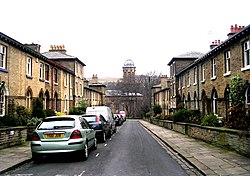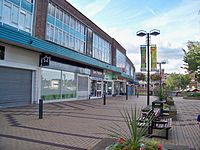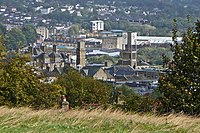Shipley
| Shipley | |
| Yorkshire West Riding | |
|---|---|
 George Street, Shipley | |
| Location | |
| Grid reference: | SE146375 |
| Location: | 53°49’59"N, 1°46’37"W |
| Data | |
| Population: | 15,483 (2011) |
| Post town: | Shipley |
| Postcode: | BD 17,18 |
| Dialling code: | 01274 |
| Local Government | |
| Council: | Bradford |
| Parliamentary constituency: |
Shipley |
Shipley is a town in the West Riding of Yorkshire, amongst the close-set industrial towns of the West Riding, such that it has become in effect a commuter-suburb for nearby Bradford. The town stands by the River Aire and the Leeds and Liverpool Canal, north of Bradford. The population at the 2011 Census was recorded at 15,483.
The town forms a continuous urban area with Bradford.
The name 'Shipley' derives from the Old English scip ('sheep', a Northumbrian dialect form) and leah ('open ground, such as meadow, pasture, or arable land'). Thus it means 'sheep-clearing' or 'sheep-pasture'.[1]
Geography
Shipley is located in the industrial belt of the West Riding of Yorkshire at an important crossing of the River Aire, where the route from Otley to Bradford crosses the route from Skipton to Leeds. It is sheltered by the millstone crags of Wrose and Windhill to the east, and to the north by Baildon and Hawksworth Moors.[2]
Development in Shipley grew upwards and outwards from the crossroads at Fox's Corner, named after the Fox and Hounds public house that once stood there.[3][4] In the Middle Ages, Shipley consisted of the settlement around the crossroads, and the unenclosed fields at Shipley Fields and the Hirst which were collectively farmed. Beyond these lay the Low Moor, which ran from the Crowghyll to the former Saltaire roundabout (now a junction on the Bradford to Keighley road), and the High Moor (from Saltaire roundabout, through Moorhead, as far as New Brighton and Noon Nick). These areas were steep, rocky land, unsuitable for farming.[5]
Outlying districts, such as Windhill, were not part of Shipley until the town growth of the 19th century. Saltaire became part of Shipley after its foundation in the 1860s, while Windhill was absorbed in subsequent years.
History
Early history
Shipley has traces of late Bronze Age settlement.[6] It is listed in the Domesday Book of 1086, in the form Scipelei(a).[1]
The early history of the place relies on the records of a succession of Lords of the Manor, not all of whom were in permanent residence. The rolls of the manor court have been missing since the 18th century,[7] leaving the records incomplete. In the 12th century, 'Adam, son of Peter', an early Lord of the Manor, granted grazing and iron ore mining rights to the monks of Rievaulx Abbey.[7] Through the Middle Ages the Lords were the 'Earls of Ormande' (sic), possibly the Irish Earls of Ormond, followed by the Gascoigne family. In 1495, Rosamund Gascoigne, a daughter of one of the William Gascoignes who held the title, married Robert Rawson, thought to be related to the Rawson family of Bradford, after whom one of the city's markets is named. Their son, William, married a cousin, Agnes Gascoigne, and through the marriage the Rawson family inherited the manor in 1570.[8]
The Rawsons lived at Over Hall known as the Manor House, on the site of the current town hall. The manor estates extended to Northcliff.[9] The family had interests in Halifax and moved there in the early 18th century, retaining their Shipley estates until the last male heir died in 1745.[10]
By the 19th century the Rawson estates and those of the Fields, another prominent land-owning family, had become the property of the Earl of Rosse[11] who had extensive holdings in Heaton. His legacy has endured in the name of a public house on the main Bradford to Keighley road, and Rossefield School in Heaton. Of the lower orders at this time not much is known, but there was relief housing offered at the town's expense near Crowghyll.[12]
Industrial Revolution

Shipley was utterly transformed by the Industrial Revolution and, in particular, the growth of the textile industry, to take its current shape. Shipley had a long history of sheep grazing, as its name suggests, so wool was plentiful, and the River Aire was a ready source of water for powering water mills and cleaning processes. There was a fulling mill in Shipley by 1500 and two more by 1559.[13] Another mill was built by the Dixon family on the banks of the Aire in 1635. The eighteenth century saw the beginning of industrialisation. New Mill on the far side of Hirst Wood was built in the 1740s and by the late 18th century between 9,000 and 10,000 pieces of broadcloth were being fulled annually at Shipley's mills.[14] Much work was undertaken in workers' cottages which had 'loomshops' for spinning yarn. Home workshops were once a common site along the River Aire and often had external flights of steps. Examples can be seen in the cottages at Jane Hills along the canal in Saltaire.[15]
The industrial era ended cottage industry. Providence Mill, one of the first steam-driven mills was built for Denby Bros. in 1796.[16] Other spinning mills followed, including Ashley Mill, Prospect Mill, Red Beck Mill on Heaton Beck (c. 1815), Well Croft Mill (c. 1840s) and Whiting Mill on Briggate.[17]
The smaller mills gave way to larger premises which could combine all the processes of worsted production on one site. The first was Joseph Hargreaves' Airedale Mills (demolished 1970s), Salts Mill (built 1853 and now a gallery and restaurant complex), an enlarged Well Croft Mill (demolished 1950s) and Victoria Mills near the canal...[18] Hargreaves employed 1,250, Salt initially 2,500 and by 1876 total employment in the mills was 6,900.[18]
The growth in textile production stimulated the growth of associated supply industries. Other local employers included loom makers, Lee and Crabtree, WP Butterfield's galvanised containers and J. Parkinson and Sons machine tool makers.[19]

The other major effect of industrialisation was the vast expansion in housing stock. Titus Salt built a new model village at the north end of Shipley, which he named Saltaire after himself and the river Aire. Hargreaves had cottages built for his workers around the town centre and his mill. He built 92 back-to-back houses along Market Street and Central Avenue in an area which came to be called Hargreaves Square or The Square. The houses were built by filling in the old courtyards.[20] The population of the township grew from 1,214 in 1822[21] to just over 3,000 in 1851 to 10,000 by 1869.[22]

It was then the landowning families—the Rosses, the Crompton-Stansfields and the Wainmans—took advantage of the demand for housing by selling their less productive land on Low Moor and High Moor. Houses for the better off were built in Sunny Bank and Hall Royd in the 1840s, 1850s and 1860s.[23] Kirkgate was lined with villas from the 1860s, some of which still stand. Middle-class houses were built in the Nab Wood and Moorhead districts. In 1870 a tranche of land in Moorhead was sold by the Countess of Rosse to build five streets of terraces. The public house on Saltaire Roundabout that bears her name dates from that time.[24]
Post-war redevelopment

The decline of the textile industry saw the demolition of many mills, only Salts Mill and Victoria Mills remain and have been converted to other uses.
Of more concern in the immediate post-war period was the deteriorating housing stock. In the 1950s, the back-to-backs of Hargreaves' Square were condemned as slums and the site redeveloped. The redevelopment removed several historic buildings – Shipley Old Hall (1593), at the junction of Kirkgate and Manor Lane[25] and of which a few fragments of roof drainage and a roof truss survive in Crowghyll Park,[26] Shipley Hall (1734), which stood at the junction of Market Street and Otley Road became the headquarters of Windhill Cooperative Society[25] and possibly Hudson Fold House (1629).[27] Of the major Victorian town centre buildings, only the Old Bradford Bank (now Barclays) and Sun Hotel remain.[28]
The slums were replaced with low-rise modern retail outlets, a central square serves as an outdoor market and an underground indoor market is situated beneath a tall, brutalist market hall tower which is a visible landmark for many miles around. Until recently the tower had a automaton of a man striking a bell to mark the hours.[29]
The Otley and Leeds Roads were widened in the early 1970s, at the expense of the Fox and Hounds Hotel after which Shipley's main road junction, Fox Corner, was named.[16]
Economy

Shipley today is dominantly residential in character, serving as a commuter suburb of larger urban employment centres in Bradford and Leeds. Manufacturing activity includes information technology specialist Pace Technologies, located in the Salts Mill complex. Marlin Windows, HC Slingsby and the offices of the Bradford Health Authority also feature among the larger employers in the town.
The town has one large scale supermarket in the town centre, but also supports smaller scale supermarkets and convenience shops. An open air market is a feature of the main commercial centre of the town as well as a covered market hall known for its landmark clock tower and 1960s brutalist architecture. A pedestrian precinct with some shops and leisure businesses links Asda and its multi-storey free car park with Market Square. This area also includes the Shipley Library and the Kirkgate Centre, the town's main cultural focus offering regular a range of community activities in addition to holding cultural events such as live music, a regular alternative market and world cinema.
The town's secondary commercial centre, Gordon Terrace, part of the historic Saltaire Village development, features independent food and fashion retailers, as well as numerous restaurants and cafes. The town has a large volume of through vehicle traffic as it is on two of the main routes between Bradford, Leeds and the Aire Valley towns of Bingley, Keighley, and Skipton.
About the town

Template:Main article The village of Saltaire located in Shipley is a UNESCO designated World Heritage Site incorporating the Victorian era Salts Mill and associated residential district. Located by the River Aire and Leeds and Liverpool Canal the model village was planned by industrialist Sir Titus Salt as a processing facility for alpaca woollen cloth and as residential accommodation for his workforce. Salts Mill is no longer used for textile production, but now contains the 1853 Gallery, housing many works by the artist David Hockney, a variety of shops, restaurants and local businesses, including Pace Micro Technology. Salts Mill is accessed via the nearby Saltaire railway station and together with the stone built terraced houses, ornate Victorian era civic buildings and Roberts Park, draws significant numbers of tourists to the area.

To the north across the River Aire, is Shipley Glen ("glen" referring to the little valley beneath a ridge). It has long been a popular beauty spot, and in 1895 the Shipley Glen Tramway was built to carry visitors up to the top. The tramway has weathered periods of neglect and closure, but in 2012 it ran most weekends through the summer, staffed by volunteers.
Churches
Traditionally, non-conformist churches have predominated in Shipley and this is still the case to some extent today. There are four Methodist churches, which feature Victorian architecture. These are: Northcliffe on the site of a 'tin chapel',[30] Crag Road, Saltaire and Christ Church at Windhill.[31]
Saltaire United Reformed Church was built in the Italianate style at the behest of Sir Titus Salt in 1859. It is a Grade I listed building.[32]

The first place of worship in Shipley was the Bethel Baptist Chapel in 1758, it was rebuilt in 1836 and demolished in the early 1970s and only part of the graveyard survives.[33] A second Baptist chapel was built at Rosse Street near the town centre in 1865 and is still in use. There is a Victorian Salvation Army Citadel on Rhodes Place.
Historically, Shipley was part of the parish of Bradford and did not have a church until well into the 19th century. The first Anglican church was the Gothic-styled St Paul's on Kirkgate, consecrated in 1826.[34] It was built at a cost of £7,687.19s.3d, a gift of the nation under the Million Act,[35] on land donated by John Wilmer Field, from the Shipley land-owning family.[33] The parish of Shipley cum Heaton was created on 30 May 1828. St Paul's is one of an identical pair of churches with Wilsden Church.[34] A graveyard was added in 1860, but by 1895 was full and additional land at Hirst Wood was consecrated.[34] The church seated 1488 and has an organ built by Binns of Bramley in 1892.[26]
Other Church of England churches in the town are St Margaret's, Frizinghall and St Peter's in Morehead Lane. The later was commissioned in 1888 as a daughter church for St Paul's and consecrated in 1909 by the [[William Boyd Carpenter|Bishop of Ripon.[36] The Roman Catholic Church of St Theresa Benedicta and St Walburga, usually referred to as St Walburga's is situated on Kirkgate.[31]
Newspapers
The town's first newspaper was the Shipley Times & Express run by stationer and printer, Johnny Walker.[3] The paper was based in premises at Shipley crossroads, and the junction was sometimes called Johnny Walker's Corner as well as Fox's Corner. In 1922, Walker sold out to printer/stationer, Osbaldiston, and the building still stands under his name. Update the building is now a scuba diving centre called Duck and Dive. The paper closed in 1981.[37]
Shipley is in the distribution area of the Bradford-based Telegraph & Argus. The Telegraph & Argus produced a free newspaper for the district, the Aire Valley (or Shipley) Target, which was then produced as one of four local editions of the Bradford & District Advertiser.[38]</ref> This no longer prints.
Shipley is also well-served by a local community magazine, The Local Leader, which distributes bi-monthly and is produced by local teenager James Slater and is based on Commercial Street.
Outside links
| ("Wikimedia Commons" has material about Shipley) |
- Salts Mill
- Shipley College
- Photographs of The Leeds & Liverpool Canal in Shipley
- St Paul's Church, Shipley
References
- ↑ 1.0 1.1 The Cambridge Dictionary of English Place-Names Based on the Collections of the English Place-Name Society, ed. by Victor Watts (Cambridge: Cambridge University Press, 2004), s.v. SHIPLEY.
- ↑ Firth 1996, p. 6.
- ↑ 3.0 3.1 Firth 1996, p. 10.
- ↑ Sheeran 1984.
- ↑ Watson 1989, p. 1.
- ↑ Burrows, p. 1.
- ↑ 7.0 7.1 Sheeran 1984, p. 5.
- ↑ Sheeran 1984, pp. 5–7.
- ↑ Sheeran 1984, p. 12.
- ↑ Sheeran 1984, p. 8.
- ↑ Sheeran 1984, p. 37.
- ↑ Sheeran 1984, p. 10.
- ↑ Sheeran 1984, p. 13.
- ↑ Sheeran 1984, p. 15.
- ↑ Sheeran 1984, p. 14.
- ↑ 16.0 16.1 Burrows, p. 2.
- ↑ Sheeran 1984, pp. 21–22.
- ↑ 18.0 18.1 Sheeran 1984, p. 23.
- ↑ Firth 1996, p. 7.
- ↑ Sheeran 1984, p. 32.
- ↑ The Edinburgh Gazetteer 1822, p. 572.
- ↑ Watson 1989, p. 4.
- ↑ Sheeran 1984, p. 35.
- ↑ Watson 1989.
- ↑ 25.0 25.1 Firth 1996, p. 15.
- ↑ 26.0 26.1 Burrows, p. 6.
- ↑ Sheeran 1984, p. 38.
- ↑ Firth 1996, p. 37.
- ↑ Burrows, p. 15.
- ↑ Burrows, p. 13.
- ↑ 31.0 31.1 Shipley Churches
- ↑ Saltaire United Reformed Church
- ↑ 33.0 33.1 Sheeran 1984, p. 21.
- ↑ 34.0 34.1 34.2 Firth 1996, p. 20.
- ↑ Burrows, p. 12.
- ↑ Watson 1989, p. 11.
- ↑ Bradford City Council: Local Newspapers
- ↑ [http://www.britishpapers.co.uk/england-yorks/bradford-advertiser/ Britishpapers.co.uk: Bradford & District Advertiser]
- Burrows, Dorothy (c. 1986). Shipley – a look at the past. Stanningley, Pudsey: Allanwood Press. ISBN 0-948423-01-3.
- The Edinburgh Gazetteer, or, Geographical Dictionary. 5. Edinburgh: Archibald Constable & Co. 1822. https://books.google.com/books?id=_2kDAAAAQAAJ&dq=shipley+yorkshire&source=gbs_navlinks_s. Retrieved 21 April 2013.
- Firth, Gary (1996). Shipley and Windhill. Stroud, Gloucestershire: Chalford. ISBN 0-7524-0615-9.
- Sheeran, George (1984). Village to Mill Town: Shipley and its Society 1600–1870. Bradford: Bradford Libraries.
- Shipley Fowk Talking. Shipley, West Yorkshire: Shipley Community History Group. 1986.
- Watson, Ian (1989). In The Shadow Of The Rosse. Shipley, Yorkshire: Shipley and District Local History Society.
